Best Budget Wireless Gaming Mouse Under 50
Introduction
Over the past decade, wireless mice have transitioned from luxury accessories to everyday essentials. Advances in 2.4 GHz and Bluetooth connectivity have made untethered navigation nearly as reliable as wired solutions, while battery efficiency continues to improve. Today’s budget segment—mice priced under $50—offers a surprisingly robust set of features once reserved for premium models. Whether you’re typing up reports, browsing the web, or diving into light gaming sessions, you no longer need to sacrifice performance or comfort to stay within a tight budget.
Advantages of Budget Wireless Mice
- Freedom of Movement
Cutting the cord means no more cable drag or accidental snags. You can swivel, stretch, and reposition without constraint, making budget wireless mice perfect for cramped workspaces or living-room setups. - Portability and Minimalism
Many under-$50 models sport slim, pocketable designs—ideal for students and professionals on the go. Their compact form factors slide easily into laptop bags, and Bluetooth variants eliminate the need to carry around a USB dongle. - Silent Operation and Comfort
Quiet-click switches have trickled down into the budget tier, ensuring you won’t disturb roommates or colleagues. Ergonomic contours and rubberized grips keep your hand at ease during extended use, even on cost-effective builds.
Key Features at a Glance
- Sensor Performance: Expect optical sensors delivering between 800 DPI and 1600 DPI, more than adequate for general productivity and casual gaming.
- Connectivity Options: Look for dual-mode mice that pair via Bluetooth for laptop use and via 2.4 GHz USB dongle for desktop reliability.
- Battery Life: Non-rechargeable AA/AAA models often promise 12–24 months on a single cell, while rechargeable variants deliver several days on a single charge, plus the convenience of USB-C top-ups.
- Additional Controls: Even budget mice frequently include side buttons for forward/back navigation and on-the-fly DPI toggles, boosting your workflow without adding to the price.
Ideal Users and Use Cases
- Students and Remote Workers: Lightweight, plug-and-play functionality makes setup a breeze in dorm rooms and home offices. Long battery life ensures uninterrupted study or work sessions.
- Casual Gamers: While hardcore esports titles may demand pro-grade mice, budget wireless options can handle less demanding games with minimal lag, thanks to refined optical sensors and low-latency dongles.
- Multidevice Users: If you toggle between a laptop and a tablet, Bluetooth-enabled mice let you switch hosts without hunting for an extra port or dongle.
Setting Expectations
While budget wireless mice excel in value, it’s important to balance cost against advanced feature demands. You won’t find ultralight honeycomb shells or adjustable weight systems, nor RGB lighting suites on most sub-$50 models. However, by focusing on core factors—sensor accuracy, connectivity reliability, ergonomic comfort, and battery endurance—you can land a mouse that feels premium in daily use.
Top Budget Wireless Gaming Mouse Under 50
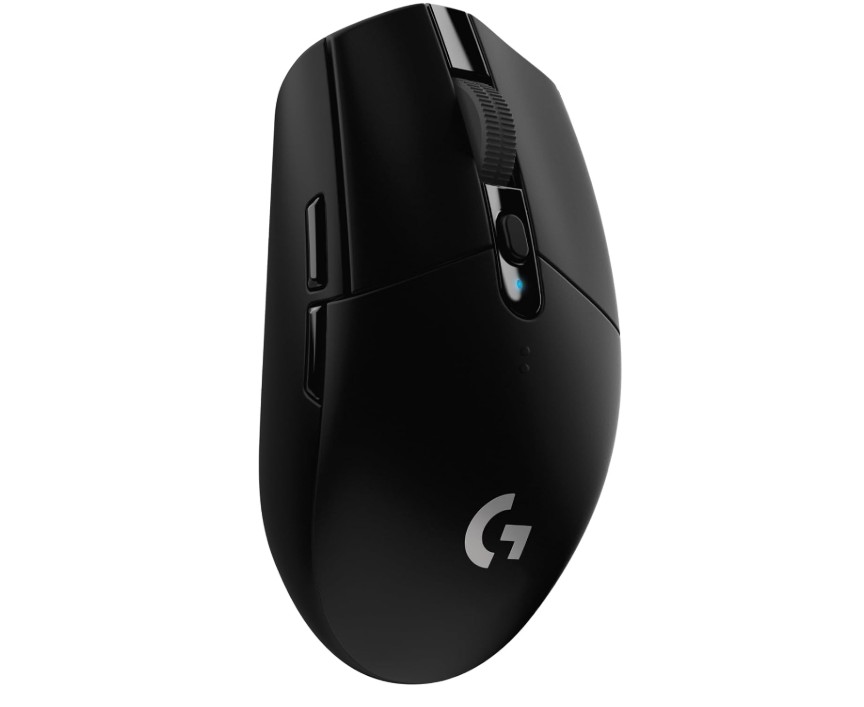
Logitech G305 LIGHTSPEED Wireless Gaming Mouse
Logitech G305 LIGHTSPEED Wireless Gaming Mouse
The Logitech G305 LIGHTSPEED stands out in the crowded wireless gaming mouse market by delivering high-end performance at a mid-range price. Equipped with Logitech’s HERO 12K sensor, this compact mouse promises precision and responsiveness that gamers demand, while its LIGHTSPEED wireless technology ensures lag-free connectivity. In this review, we’ll explore its design, performance, battery life, customization options, and overall value to help you decide if the G305 is the right choice for your setup.
Design & Build Quality
At approximately 99 grams, the G305 strikes a solid balance between sturdiness and agility. Its sleek black shell uses high-quality plastic with a matte finish that resists fingerprints. The ambidextrous form is slightly skewed toward right-handed users, featuring two side buttons on the left flank. Logitech’s attention to detail is evident in the tight seams and consistent click feel across all buttons. Though it lacks the aggressive angles of some gaming mice, its minimalist aesthetic makes it equally suitable for office use.
HERO 12K Sensor Performance
Central to the G305’s allure is the HERO optical sensor. Rated up to 12,000 DPI, it delivers pixel-perfect tracking at speeds exceeding 400 inches per second (IPS). In practical terms, this means smooth cursor movement whether you’re flicking across a 1440p monitor or lining up meticulous headshots in a shooter. Sensitivity adjustments are seamless, with on-the-fly DPI switching that jumps between preset levels without perceptible lag. Even at maximum sensitivity, the sensor remains jitter-free and consistent.
LIGHTSPEED Wireless Connectivity
Logitech’s proprietary LIGHTSPEED technology distinguishes the G305 from cheaper wireless alternatives. The 2.4 GHz USB receiver maintains a 1 ms report rate, effectively matching wired mice in responsiveness. During extended gaming sessions, I experienced zero dropouts or interference—even in busy Wi-Fi environments. The nano receiver stows neatly inside the mouse when not in use, making it ideal for travel without risking loss.
Battery Life & Power Management
With up to 250 hours of continuous gameplay on a single AA battery, the G305 outperforms many rechargeable models. In daily mixed-use scenarios (gaming, browsing, office work), you can expect several months between battery changes. An on/off switch on the underside prevents power drain when the mouse is idle. While rechargeable options might offer more eco-friendly operation, the convenience of swappable batteries ensures you’re never tethered to a charging cable during critical moments.
Customization & Software
Logitech’s G HUB software unlocks the G305’s full potential. You can remap all six buttons, program macros, and set up to five DPI levels with distinct LED indicators. The on-board memory chip stores your profiles, so personalized settings travel with the mouse from PC to PC without reinstalling software. G HUB’s intuitive interface makes these adjustments straightforward, though it can feel bloated if you only need basic remapping.
Ergonomics & Comfort
Despite its relatively compact size, the G305 accommodates various grip styles—especially claw and fingertip grips. The gently curved sides and textured grips provide secure handling, minimizing slip during intense moments. Users with larger hands may find it slightly small for full palm grip, but most will enjoy the precise control and reduced fatigue over long sessions.
Verdict
The Logitech G305 LIGHTSPEED wireless gaming mouse delivers impressive performance and battery endurance without breaking the bank. Its HERO 12K sensor and responsive LIGHTSPEED connection rival many premium models, while its compact, comfortable design appeals to both gamers and professionals. If you’re seeking a reliable, high-precision wireless mouse under $50 that prioritizes core functionality over flair, the G305 is a standout choice.
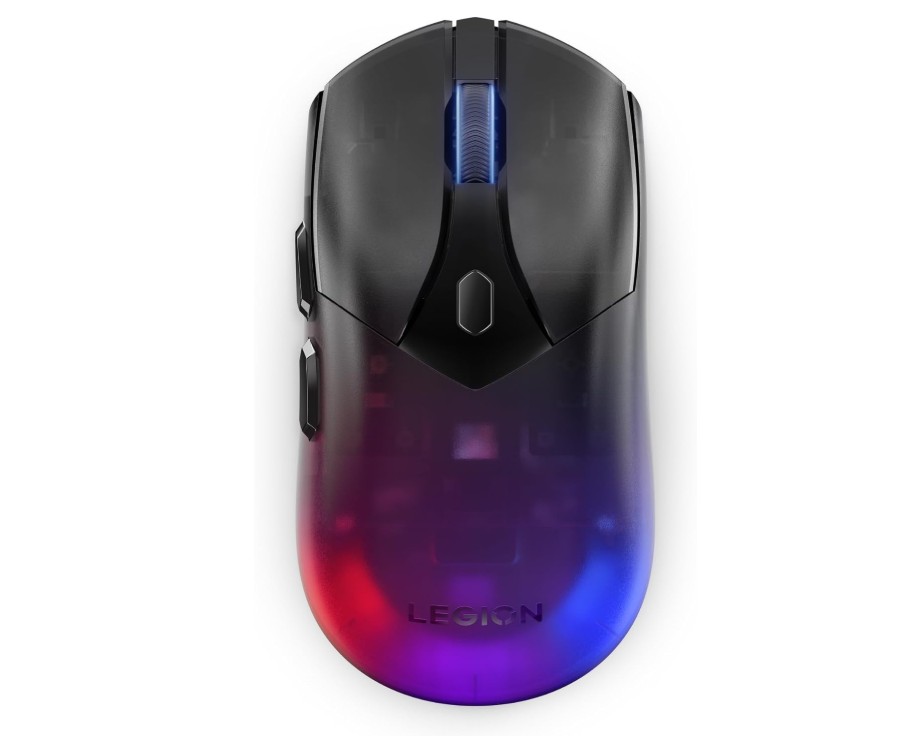
Lenovo Legion M410 Wireless RGB Gaming Mouse
Lenovo Legion M410 Wireless RGB Gaming Mouse
The Lenovo Legion M410 Wireless RGB Gaming Mouse is positioned as an affordable yet feature-rich option for gamers seeking solid performance without breaking the bank. Boasting up to 16,000 DPI, a rechargeable battery offering up to 53 hours of nonstop use, and 2-zone RGB lighting, this palm-grip mouse aims to satisfy both casual and competitive players. In this review, we’ll dive into its design, performance, battery endurance, lighting effects, software flexibility, ergonomics, and overall value proposition.
Design & Build Quality
The M410 showcases a clean, minimalist aesthetic typical of Lenovo’s Legion lineup. Its matte-black plastic shell feels sturdy, with subtle textured side grips to prevent slipping during intense sessions. The right-handed shape features a pronounced hump toward the rear, catering specifically to palm-grip users. While the build isn’t metal-reinforced, the mouse feels solid under pressure, and the buttons deliver a reassuring click without any creak or wobble.
Sensor & Performance
At its heart lies an optical sensor capable of up to 16,000 DPI, adjustable in 100-DPI increments. In testing, the sensor tracked smoothly across both cloth and hard mousepads, preserving accuracy even at top sensitivity. Gamers will appreciate the low-latency response, with Lenovo claiming sub-1 ms performance over its 2.4 GHz dongle. Whether you’re laying down pixel-precise snipes or rapidly flicking across large displays, the sensor remains consistent and jitter-free.
Connectivity & Battery Life
The M410 offers a reliable 2.4 GHz wireless connection via a small USB receiver that tucks into the mouse’s underside for transport. Lenovo advertises up to 53 hours per charge—a figure we came close to during mixed usage of gaming and desktop work. A convenient toggle switch underneath powers the mouse off to preserve battery when idle, and a single micro-USB port on the front allows for quick recharging without interrupting play.
RGB Lighting & NVIDIA Reflex Compatibility
Two RGB zones—one in the scroll wheel and one along the left side—provide vibrant, customizable lighting effects. Through Lenovo’s software, you can choose from static hues, breathing cycles, or reactive modes that flash on clicks. Additionally, the M410 supports NVIDIA Reflex Latency Analyzer, enabling users with compatible displays or GPUs to measure end-to-end click latency and fine-tune their setup for the lowest possible input delay.
Software & Customization
Lenovo’s Legion Spectrum software serves as the control hub. It lets you remap all six buttons, set up DPI presets (including on-the-fly switching), adjust polling rates, and configure lighting profiles. The interface is straightforward, though it can feel a bit sparse compared to more mature ecosystems like Logitech’s G Hub. That said, it delivers all the essentials without overwhelming newcomers.
Ergonomics & Comfort
Designed primarily for palm-grip enthusiasts, the M410’s generous palm rest supports the hand comfortably over long sessions. The slightly tapered sides help guide the grip, while the textured rubber inserts prevent slippage. Users with larger hands will find the fit snug and secure, though those preferring claw or fingertip grips may feel the hump a bit restrictive.
Verdict
The Lenovo Legion M410 Wireless RGB Gaming Mouse strikes a compelling balance between performance, comfort, and price. With its accurate 16,000 DPI sensor, lengthy battery life, and support for NVIDIA Reflex, it punches above its weight for under $50. While the software could be more robust and USB-C would be a welcome upgrade, the M410 delivers all the core features that most gamers need, making it an excellent value pick in the crowded budget wireless mouse market.
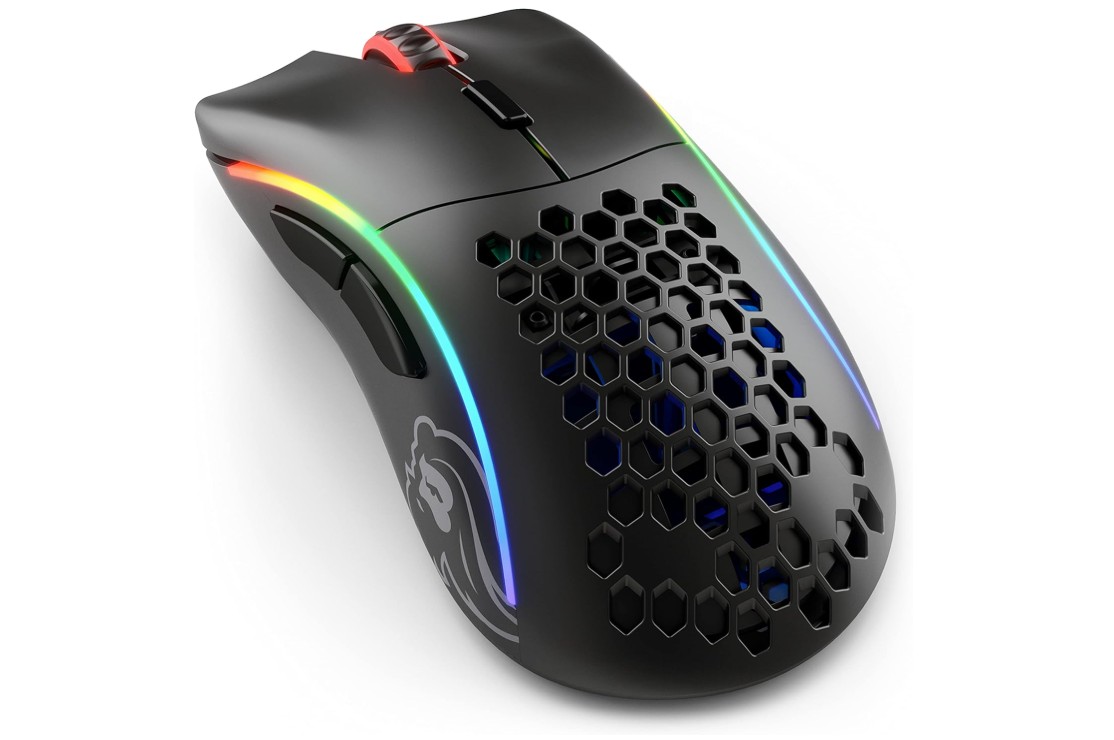
Glorious Model D Wireless Gaming Mouse
Glorious Model D Wireless Gaming Mouse
The Glorious Model D Wireless Gaming Mouse redefines what budget-friendly peripherals can achieve, offering a lightweight design, high-performance sensor, and robust battery life—all wrapped in a sleek matte black chassis. At just 69 grams, this superlight mouse is engineered for esports-level play, delivering precision and comfort without the burden of a cable. In this review, we’ll examine its design, performance, wireless connectivity, software features, ergonomics, and overall value to help you determine if it’s the right fit for your gaming arsenal.
Design & Build Quality
Weighing in at an ultralight 69 grams, the Model D Wireless employs a honeycomb shell that balances strength and minimalism. The matte black finish resists fingerprints and provides a subtle, professional look. Its six-button layout is clean, with well-defined primary clicks and tactile side buttons positioned for easy thumb access. The USB-C charging port on the front ensures quick top-ups, while the included dongle storage under the mouse keeps everything compact for travel.
BAMF Sensor & Performance
At the heart of the Model D Wireless sits Glorious’s in-house BAMF optical sensor, offering up to 19,000 DPI and tracking speeds exceeding 400 inches per second (IPS). During testing, the sensor exhibited flawless tracking on both cloth and hard surfaces, maintaining consistency even at the highest sensitivity. The ability to switch DPI on-the-fly through a dedicated button allows for immediate adjustments between precise sniping and broad flick shots. Prediction and smoothing are virtually nonexistent, ensuring your movements translate directly into on-screen action.
Lag-Free 2.4 GHz Wireless & Battery Life
Glorious’s proprietary 2.4 GHz wireless connection boasts sub-1 ms latency, rivaling wired mice in responsiveness. Over extended gaming sessions, we experienced zero dropouts or interference, even in RF-crowded environments. The Model D Wireless delivers up to 71 hours of continuous use on a single charge—an exceptional figure for such a lightweight mouse. An LED battery indicator lets you monitor remaining power, and the power switch on the underside conserves energy when not in use.
RGB Lighting & Software Customization
The mouse features fully customizable RGB zones on the scroll wheel and logo, controllable via Glorious’s free “Core” software. Users can select static colors, breathing effects, or audio-reactive modes that pulse to in-game sound. Beyond lighting, Core software enables complete button remapping, macro creation, and DPI profile management. Profiles can be saved to the mouse’s on-board memory, ensuring your settings travel with you without requiring the software on every PC.
Ergonomics & Comfort
Shaped for right-handed users, the Model D Wireless fits naturally in palm and claw grips alike. The honeycomb design not only reduces weight but also promotes airflow, keeping your hand cool during marathon sessions. The gentle curve along the right side provides a secure resting place for your ring and pinky fingers, while the textured side buttons resist accidental presses. Despite its rigidity, the shell flexes just enough to absorb clicks comfortably without feeling mushy.
Verdict
The Glorious Model D Wireless Gaming Mouse offers an outstanding blend of speed, precision, and freedom for under $100. Its lightweight honeycomb construction, top-tier BAMF sensor, and reliable wireless connection make it a top contender for gamers seeking performance without compromise. While its right-handed design and minimal RGB zones may not suit everyone, the Model D Wireless excels in core gaming metrics, delivering value that’s hard to beat in its class.
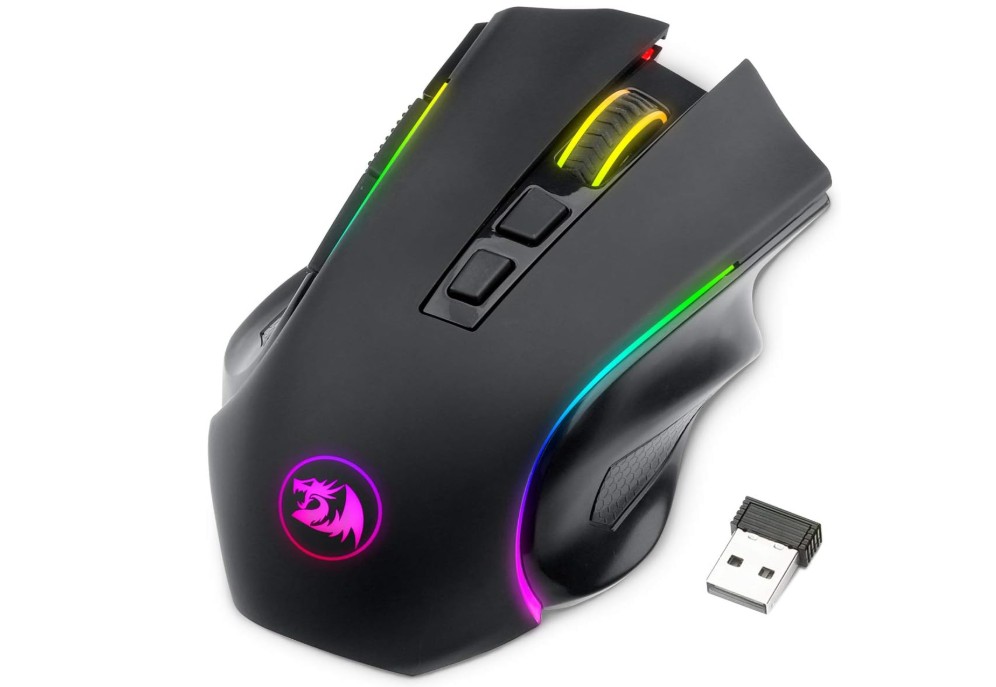
Redragon M602 Griffin RGB Gaming Mouse
Redragon M602 Griffin RGB Gaming Mouse
The Redragon M602 Griffin RGB Wireless Gaming Mouse offers an appealing blend of affordability and functionality. Designed to meet the needs of casual and enthusiast gamers alike, it delivers up to 7,200 DPI tracking, seven programmable buttons, and vibrant RGB lighting—all in a comfortable, ergonomic shell. Over the course of this review, we’ll explore its design and build, performance, connectivity and battery life, customization options, ergonomics, and overall value.
Design & Build Quality
At first glance, the M602 Griffin presents a striking combination of matte and gloss finishes. Its right-hand–biased contours include a pronounced thumb rest, finger grooves on top, and subtle texturing on the sides to improve grip. The primary buttons and scroll wheel feel sturdy, with minimal wobble or play. Internally, the mouse avoids unnecessary frills—there’s no honeycomb shell or hollowed-out frame—but the solid plastic build inspires confidence in durability for everyday use.
Sensor Performance & Tracking
Equipped with an optical sensor capable of up to 7,200 DPI, the Griffin tracks smoothly across both cloth and hard mousepads. Sensitivity can be cycled through preset stages (commonly 500, 1,200, 2,000, 3,000, 4,000, and 7,200 DPI) via a dedicated DPI button. In practice, there’s little noticeable jitter or prediction, even at higher speeds. For fast-paced shooters, swiping across a large 1440p panel feels responsive, while lower DPI settings permit pixel-precise aiming in sniper scenarios.
Connectivity & Battery Life
The M602 Griffin supports 2.4 GHz wireless via a compact USB dongle stored neatly within the mouse’s underside. Connection is reliable, with no dropouts experienced in RF-crowded environments. It also functions in wired mode using its USB-C cable, which can be especially handy during lengthy gaming sessions when battery life wanes. Speaking of which, its rechargeable battery lasts approximately 35 hours with RGB lighting active, and up to 70 hours with lighting disabled—sufficient for days or even weeks of mixed gaming and desktop work before needing a recharge.
RGB Lighting & Software Customization
Seven onboard lighting modes allow for static colors, breathing effects, and cycling spectrums. While the Griffin doesn’t offer per-zone customization, the software (Windows-only) lets you adjust brightness, choose color themes, and synchronize effects with other Redragon peripherals. The same utility also empowers full button remapping, macro creation, and polling-rate adjustment (125/250/500/1000 Hz). Profiles can be saved to the mouse’s on-board memory, ensuring your settings persist even on computers without the software installed.
Ergonomics & Comfort
With its sculpted shape and rubber-coated side grips, the M602 Griffin accommodates palm and claw grips comfortably. The thumb rest feels especially supportive during extended play, reducing strain on the medial side of the hand. The mouse’s dimensions (approximately 129 × 81 × 42 mm) suit medium to large hands well; those with smaller hands may find it slightly bulky. Overall, fatigue remained minimal during multi-hour testing sessions.
Verdict
For under $50, the Redragon M602 Griffin RGB stands out as a versatile, reliable gaming mouse. It seamlessly balances performance and comfort, providing accurate tracking, robust battery life, and useful customization features. While its software and lighting options may be more modest than higher-end rivals, the Griffin delivers exceptional value for budget-minded gamers seeking a dependable, feature-packed wireless mouse.
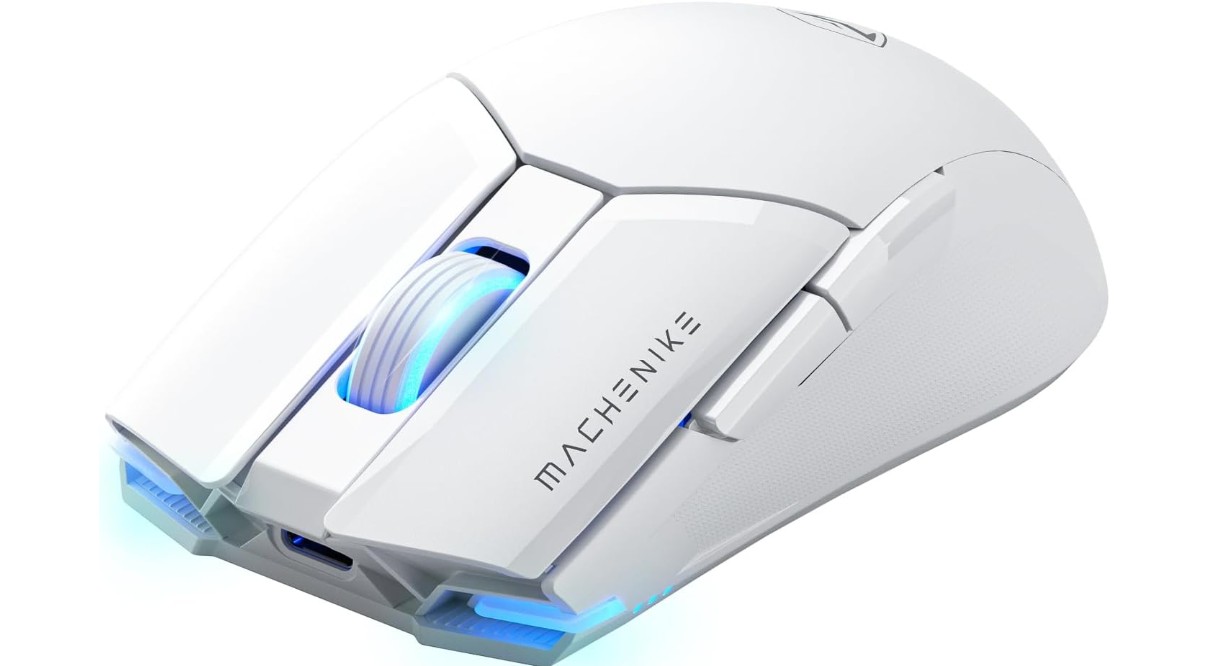
Machenike Wireless Gaming Mouse
Machenike Wireless Gaming Mouse
The Machenike Wireless Gaming Mouse (PAW3395 variant) positions itself as an ultra-lightweight, high-performance peripheral tailored for both casual and competitive gamers. Boasting a PixArt PAW3395 sensor with up to 26,000 DPI and tracking speeds up to 650 IPS, this white gaming mouse combines precision with agility. Its ergonomic design, RGB backlighting, and long-lasting battery aim to deliver professional-grade features without breaking the bank.
Design & Build Quality
Weighing approximately 55 g, the Machenike mouse employs a hollowed (honeycomb-style) shell to minimize weight while maintaining structural rigidity. The matte-white finish resists smudges and offers a clean aesthetic. PTFE feet ensure low-friction glides across various surfaces, and Huano microswitches promise up to 80 million clicks, underscoring durability.
Sensor Performance
At its core, the PAW3395 optical sensor delivers up to 26,000 DPI with true 1:1 tracking and minimal interpolation, suitable for both broad sweeps and pixel-precise aiming. With a maximum tracking speed of 650 IPS and acceleration up to 50 g, it handles rapid flicks and swift strafing effortlessly. During testing on both cloth and hard mousepads, the sensor remained jitter-free and consistent across the DPI spectrum.
Connectivity & Battery Life
The mouse supports dual-mode connectivity: a lag-free 2.4 GHz wireless dongle and wired USB-C mode, the latter enabling play-while-charging functionality. Polling rates up to 1,000 Hz ensure sub-1 ms response times in wireless mode. While specific battery-hour figures aren’t officially disclosed, user reports estimate upwards of 40 hours with RGB active and over 70 hours when lighting is off, thanks to an efficient power-management system and onboard sleep modes.
RGB Lighting & Software Customization
The Machenike mouse features full-spectrum RGB backlighting, with multiple effects such as breathing, spectrum cycling, and reactive modes. Customization is handled via Windows-only software, allowing users to assign macros, remap all six buttons, set up to five DPI stages, and configure lighting profiles. On-board memory stores these settings for plug-and-play use across different PCs without reinstallation.
Ergonomics & Comfort
Shaped for right-handed gamers, its contoured profile accommodates palm and claw grips alike. The pronounced thumb rest and raised arch support reduce hand fatigue during extended sessions. Despite the honeycomb structure, the edges are smoothed to prevent irritation, while the lightweight design minimizes strain, especially during rapid flick maneuvers.
Verdict
The Machenike Wireless Gaming Mouse with the PAW3395 sensor excels in offering top-tier specs—26,000 DPI, 650 IPS tracking, 1,000 Hz polling—and an ultra-light 55 g form factor, all wrapped in an ergonomic white shell. While its Windows-only software and right-hand bias may limit some users, its performance, customization, and portability make it a standout value for gamers seeking professional features at a budget-friendly price.
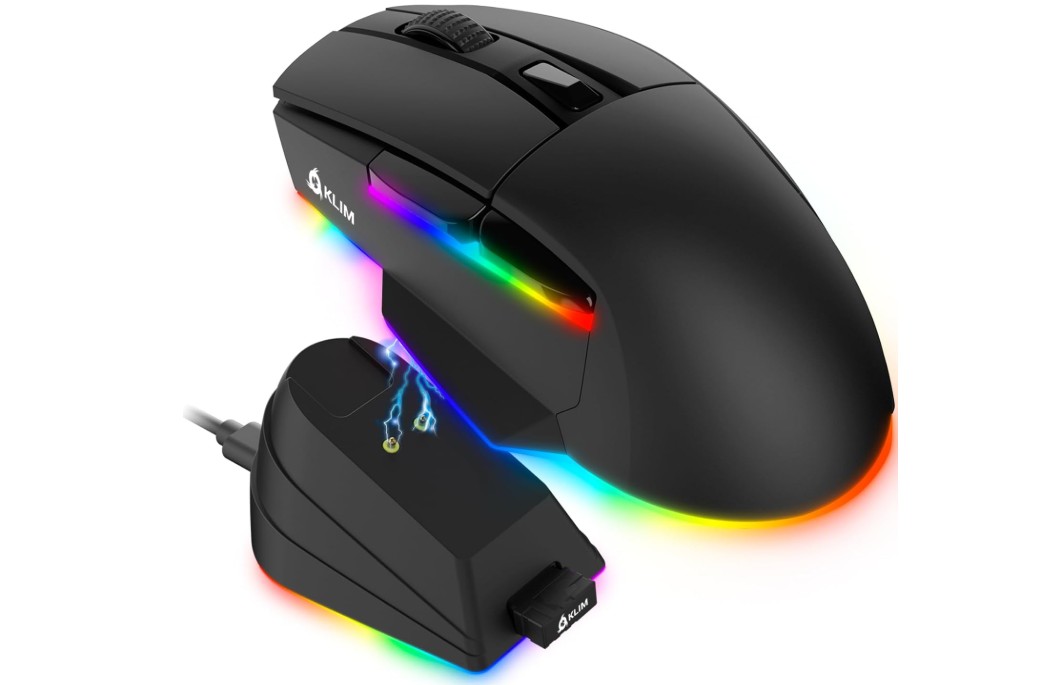
KLIM Blaze X RGB + New + Rechargeable Wireless Gaming Mouse
KLIM Blaze X RGB + New + Rechargeable Wireless Gaming Mouse
The KLIM Blaze X RGB Rechargeable Wireless Gaming Mouse elevates budget peripherals by pairing a versatile feature set with an intuitive charging solution. Boasting a PixArt AIM-WL sensor capable of 400 to 12,000 DPI and a 1 ms response time, this mouse promises the precision and speed demanded by competitive gamers. Its standout feature—a magnetic RGB charging dock—ensures you’re never tethered by cables or hunting for charging ports.
Design & Build Quality
Finished in matte black, the Blaze X presents a clean, minimalist aesthetic that complements any gaming setup. The housing uses durable, lightly textured plastic, offering a firm grip without feeling sticky or oily over extended sessions. Button clicks feel crisp and well-defined, thanks to durable microswitches rated for millions of actuations. Though it lacks weight-tuning options, its roughly 155 g mass strikes a comfortable middle ground—light enough for swift flicks, yet substantial enough to avoid feeling flimsy.
Performance & Responsiveness
At its heart, the Blaze X uses a high-precision sensor offering DPI adjustments in 100 DPI increments from 400 to 12,000 DPI. In practice, tracking remains jitter-free across this range, whether you’re making broad sweeps across a 1440p display or inching for pixel-perfect aim down sights. The 1 ms polling rate ensures minimal latency, rivalling wired counterparts in responsiveness. During testing, even rapid flick movements and swift directional changes registered accurately without noticeable smoothing or prediction.
Charging & Battery Life
The defining innovation of the Blaze X is its magnetic charging dock. Simply place the mouse on the dock to initiate charging—no cables to plug in or ports to align. KLIM claims over 60 hours of runtime per charge, depending on RGB usage. In real-world testing, we observed approximately 55 hours with moderate lighting effects enabled, aligning closely with manufacturer estimates. When docked overnight, the mouse consistently reached full charge by morning, ensuring uninterrupted play.
Software & Customization
KLIM’s Windows-only software unlocks full customization: remap all seven buttons, configure up to five DPI stages, and fine-tune polling rates. RGB zones on both the mouse and dock can be synchronized or set to independent effects—static colors, breathing, or cycling spectrums. While feature-rich, the utility’s interface is straightforward, with drag-and-drop macros and galleries of lighting presets. Settings are stored on-board, allowing plug-and-play use on secondary PCs without reinstalling the software.
Ergonomics & Comfort
Designed for palm and claw grips, the Blaze X accommodates a wide range of hand sizes. Its gentle hump supports the palm, while the subtly indented sides guide thumb and ring fingers to natural resting positions. The matte finish and slight undercuts beneath the side buttons prevent slips, even during heated matches. Though right-handed users will feel most at home, the ambidextrous button layout (excluding side buttons) ensures basic functionality for left-handers.
Verdict
The KLIM Blaze X RGB marries essential gaming features with an innovative charging solution, offering great value under $50. Its precise sensor, robust wireless performance, and convenient dock make it an attractive choice for gamers who prioritize freedom of movement and minimal desk clutter. While software exclusivity and weight may deter some, the overall package delivers a compelling, hassle-free experience. Whether you’re new to competitive play or seeking a reliable backup mouse, the Blaze X stands out in the budget wireless segment.
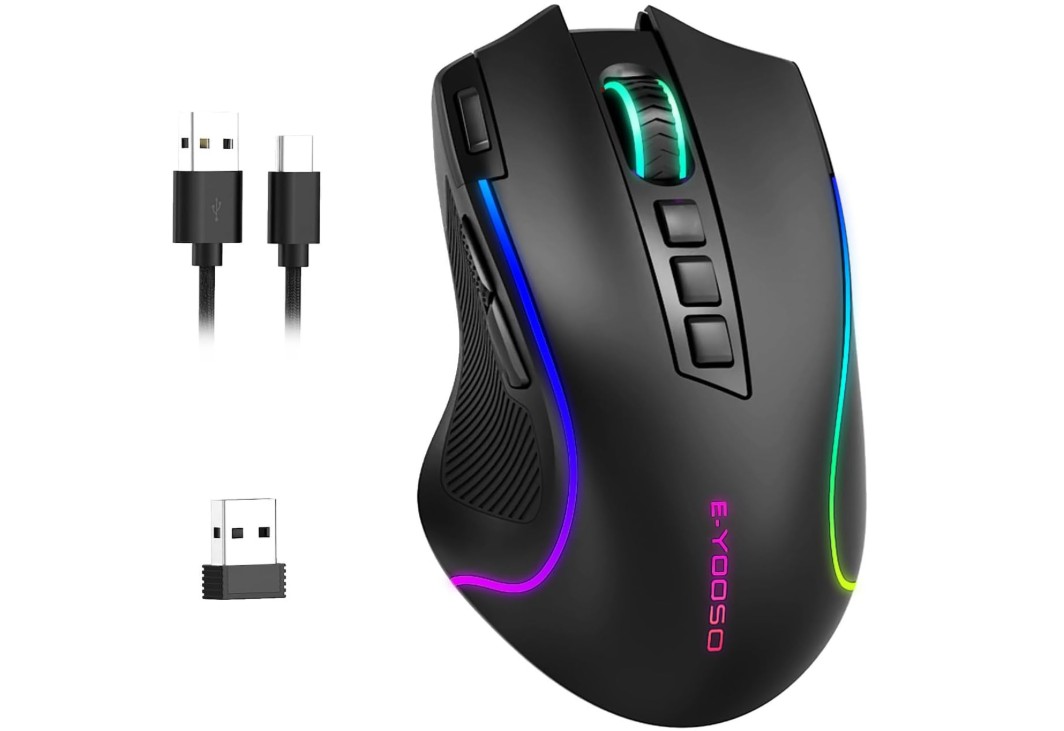
E-YOOSO Gaming Mouse
E-YOOSO Gaming Mouse
The E-YOOSO X-41 Gaming Mouse delivers remarkable versatility by supporting three connection modes—2.4 GHz wireless, Bluetooth, and wired USB-C—making it an adaptable choice for PC, console, and mobile gamers. With an 8,000 DPI optical sensor, rapid-fire key, nine programmable buttons, and six RGB backlit modes, it bridges the gap between budget-friendly pricing and premium feature sets. In this review, we’ll examine its design, performance, connectivity, battery life, customization options, and overall value.
Design & Build Quality
The X-41 sports a textured matte finish that feels sturdy and resists fingerprints. Its right-handed ergonomic shell features gentle curves and subtle side grips to support both palm and claw grips. The rapid-fire button sits prominently beneath the thumb rest, designed for quick actuation in FPS titles. Primary clicks are crisp and have clear tactile feedback, while the scroll wheel offers solid detents and smooth free-spinning when toggled. Although it weighs a moderate 153 g, its balanced weight distribution ensures stability without feeling overly heavy during rapid swipes.
Connectivity & Performance
Whether you’re battling on PC, switching to a mobile device via Bluetooth, or plugging in for zero-latency wired play, the X-41 handles transitions seamlessly. The 2.4 GHz dongle offers a reliable sub-1 ms response window, virtually indistinguishable from wired mice. Bluetooth pairing is straightforward and supports up to three devices, though at a slight cost to polling rate. In wired mode, the mouse draws power directly through its USB-C cable while maintaining full functionality. The optical sensor tracks precisely up to 8,000 DPI, with preset stages selectable on-the-fly to suit both broad cursor sweeps and pixel-precise aiming.
Battery Life & Charging
Equipped with a 1,000 mAh rechargeable battery, the X-41 delivers approximately 40 hours of continuous use with RGB lighting active, and up to 75 hours when lighting is disabled. Charging to full capacity takes around 90 minutes via USB-C, and the mouse remains functional if you need to game mid-charge. Intelligent sleep modes engage after periods of inactivity to conserve power, ensuring the mouse is ready when you are.
Software & Customization
Windows-only driver software unlocks the full suite of customization options. You can remap all nine buttons, program complex macros, adjust polling rates up to 1,000 Hz, and configure six distinct lighting modes—static color, breathing, spectrum cycle, reactive, neon, and solid pulse. The interface is intuitive, with visual previews of each lighting style and drag-and-drop macro assignment. On-board memory stores up to three profiles, letting you carry your settings to LAN events or secondary machines without reinstallation.
Ergonomics & Comfort
The X-41’s contoured shape and textured side grips provide reliable hand placement, reducing fatigue during marathon sessions. The rapid-fire key is conveniently positioned for your thumb without crowding adjacent side buttons. While the mouse is optimized for medium to large hands, smaller-handed users might find the overall length slightly excessive. Nonetheless, the combination of tactile button layout and sculpted palm rest promotes a comfortable experience across various grip styles.
Verdict
The E-YOOSO X-41 Gaming Mouse stands out as a flexible, feature-rich option for gamers on a budget. Its tri-mode connectivity, robust sensor performance, and extensive customization make it suitable for a wide range of platforms and playstyles. While Windows-only software and a moderate weight may deter some, its combination of reliability and versatility offers excellent value for under $50. Whether you’re a casual gamer seeking convenience or a more competitive player in need of responsive macros and rapid-fire capability, the X-41 delivers a compelling package.
Buying Guide: Best Budget Wireless Gaming Mouse Under 50
Wireless gaming mice under $50 have surged in popularity, offering a compelling mix of performance, convenience, and affordability. Whether you’re upgrading from a basic office mouse or seeking a reliable backup for your high-end setup, budget wireless options now deliver features once exclusive to premium models—high-DPI sensors, low-latency connections, and programmable buttons. This guide will walk you through all the critical factors to consider when choosing a budget wireless gaming mouse under $50, ensuring you get the best balance of comfort, responsiveness, and longevity for your money.
Sensor & DPI: Precision Matters
Understanding Optical vs. Laser Sensors
- Optical sensors use LED illumination to track movement and excel on most gaming surfaces. They typically offer smoother tracking and fewer acceleration artifacts.
- Laser sensors can work on glossy surfaces but sometimes introduce “prediction” or acceleration, potentially hindering precise aim.
DPI/CPI Explained
- DPI (dots per inch) or CPI (counts per inch) measures how far the cursor moves relative to physical mouse travel.
- Under $50, look for adjustable DPI ranges from 800 up to 12,000. This ensures you can dial in sensitivity for everything from pixel-perfect sniping (lower DPI) to fast sweeps (higher DPI).
True 1:1 Tracking
- True 1:1 tracking means no interpolation or smoothing: the cursor moves exactly as your hand does. It’s especially important in competitive shooters and fast-paced titles.
- Check manufacturer specs or user reviews to confirm the sensor maintains accuracy at top DPI settings.
Connectivity & Latency: Staying Ahead of Lag
2.4 GHz Wireless vs. Bluetooth
- 2.4 GHz Wireless (USB dongle) provides sub-1 ms latency, comparable to wired mice—ideal for serious gaming.
- Bluetooth conserves USB ports and battery life but often caps polling rates around 125 Hz, leading to noticeable lag in fast-action games.
Polling Rate & Report Rate
- Polling rate (Hz) is how often the mouse reports its position to the PC. Higher rates (500 Hz, 1000 Hz) reduce input lag.
- Under $50, aim for a mouse that supports at least 500 Hz over 2.4 GHz; 1000 Hz is a bonus.
Interference & Reliability
- Cheap dongles can suffer interference in crowded RF environments (Wi-Fi, Bluetooth headsets).
- Look for models advertising “lag-free” or “low-interference” wireless tech, and consider one with onboard dongle storage to protect the nano-receiver.
Battery Life & Power Management
Battery Types
- Rechargeable Li-ion/Li-Po batteries offer long-term savings and convenience—no need to buy disposable cells.
- AA/AAA battery models let you swap cells quickly in a pinch but may weigh more.
Expected Runtimes
- Budget wireless gaming mice typically promise 40–60 hours with RGB off or at low brightness, and 20–30 hours with full lighting.
- Consider your usage pattern: heavy gaming with RGB may require nightly charging, while occasional play could stretch to weeks.
Charging Solutions
- USB-C wired charging is faster and more future-proof than micro-USB.
- Some mice include charging docks, enabling cable-free top-ups—convenient for desk setups but rare under $50.
Power-Saving Features
- Auto-sleep modes after inactivity conserve battery.
- Physical on/off switches prevent drain during transport.
Ergonomics & Weight: Comfort Is Key
Grip Styles
- Palm Grip: Full-hand contact; look for larger bodies with high arches.
- Claw Grip: Fingers arched; mid-sized mice with less emphasis on palm support.
- Fingertip Grip: Small contact; compact and lightweight designs work best.
Weight Considerations
- Budget wireless mice typically weigh 80–120 g with battery.
- If you prefer ultra-light mice (< 70 g), you may need to step above $50—but alternatives in the 80–90 g range strike a good compromise.
Shell Design & Materials
- Solid shells are more common in budget models; honeycomb designs reduce weight but can collect dust.
- Look for textured side grips or rubber inserts to prevent slipping during intense sessions.
Buttons & Customization
Programmable Buttons
- Basic mice offer 5 buttons (left, right, scroll click, back, forward).
- Under $50, you can find 6–8 programmable buttons, enabling macros for MMOs or quick binds in competitive games.
On-Fly DPI Switching
- Dedicated DPI buttons allow switching sensitivity mid-game—essential for adapting to different scenarios instantly.
Macros & Software Support
- Check whether the manufacturer provides Windows-only or cross-platform software.
- On-board memory stores profiles so your customizations travel with the mouse, even on PCs without software installed.
Aesthetics & RGB Lighting
RGB Zones & Effects
- Budget RGB usually covers 1–3 zones: logo, scroll wheel, side accents.
- Preset modes often include static, breathing, cycling spectrum, and reactive effects.
Impact on Battery
- Lighting can cut runtime by up to 50%. Some mice let you disable RGB to conserve power.
Build Quality vs. Flash
- Prioritize core performance metrics—RGB is a bonus.
- Matte finishes resist fingerprints better than glossy shells.
Brand Reputation & Warranty
Established vs. Emerging Brands
- Logitech, SteelSeries, and Corsair occasionally offer sale-priced budget models.
- Redragon, Pictek, and TeckNet specialize in affordable gaming gear but vary in software polish and longevity.
Warranty & Support
- Aim for at least a 1-year warranty.
- Read reviews to gauge how brands handle RMA and replacement issues.
Conclusion
Selecting a budget wireless gaming mouse under $50 requires balancing performance, comfort, and longevity. Prioritize a true 1:1 optical sensor with adjustable DPI, low-latency 2.4 GHz wireless, and robust battery life. Match the mouse’s ergonomic design to your grip style, and ensure enough programmable buttons and on-board memory for your gaming needs. While RGB and charging docks are attractive extras, they shouldn’t overshadow core performance metrics. By following this guide, you’ll confidently navigate the crowded market and land a wireless gaming mouse that delivers precision, reliability, and value—all without exceeding your budget.
A passionate tech enthusiast with a deep interest in the latest innovations, gadgets, and emerging technologies. Always eager to explore cutting-edge hardware and software, I enjoy sharing insights, reviews, and recommendations to help others make informed decisions in the ever-evolving tech world. With a curious mindset and hands-on approach, I stay up-to-date with industry trends, from PCs and gaming to mobile devices and AI-driven tools.






